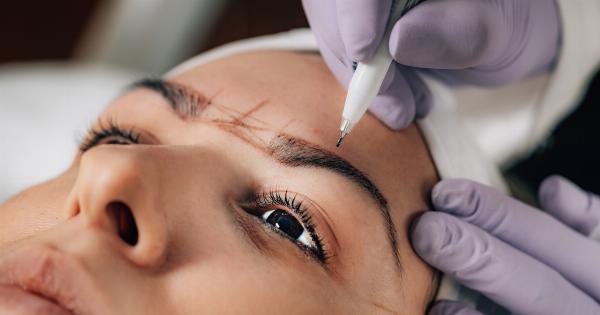Tattoos have been a part of human culture for centuries, serving as symbols of identity, self-expression, and artistry. However, as people change and grow, so do their perceptions of their tattoos.
What might have once been a cherished piece of body art can later become a source of regret or discomfort. In the past, removing tattoos was a difficult and often painful process, but thanks to revolutionary advancements in technology, a new era of tattoo removal has dawned.
The Traditional Methods of Tattoo Removal
Historically, tattoo removal methods were limited in effectiveness and often left individuals with unsightly scars or long-lasting pain. Some of the traditional methods of tattoo removal included:.
1. Dermabrasion
Dermabrasion involved physically sanding the tattooed skin to remove the top layer. This procedure was painful and often resulted in bleeding, infection, and scarring.
2. Excision
Excision was a surgical procedure where the tattooed skin was cut out, and the edges were stitched together. This method was invasive, painful, and often left visible scars.
3. Salabrasion
Salabrasion involved rubbing salt onto the tattooed area until the skin became raw. The area was then scrubbed with a sponge or abrasive pad. Although this method was relatively inexpensive, it was extremely painful and could lead to infections.
The Revolutionary Solution: Laser Tattoo Removal
Laser tattoo removal has transformed the world of tattoo removal, offering a safe, effective, and virtually painless solution.
This revolutionary method uses laser technology to break down the ink particles in tattoos without causing significant damage to the surrounding skin.
How Laser Tattoo Removal Works
Laser tattoo removal works by targeting the pigment in the tattoo ink with concentrated beams of light. The laser energy is absorbed by the ink particles, causing them to shatter into tiny fragments.
Over time, the body’s immune system recognizes these fragments as foreign objects and gradually eliminates them through the lymphatic system.
The Process of Laser Tattoo Removal
Laser tattoo removal is a multi-step process that typically requires multiple sessions for complete removal. The process involves:.
1. Consultation
Prior to the first laser treatment, individuals undergo a consultation with a professional tattoo removal specialist.
During this consultation, the specialist assesses the tattoo, discusses the expected number of sessions, and sets realistic expectations for the removal process.
2. Preparing the Skin
Before each laser treatment, the tattooed area is cleaned, and a topical numbing cream or cold air may be applied to minimize any discomfort during the procedure.
3. Laser Treatment
The laser emits short bursts of intense light onto the tattooed area. The sensation can range from a mild stinging to the feeling of a rubber band snapping against the skin. Most individuals tolerate the procedure well, but pain thresholds can vary.
4. Post-Treatment Care
After each laser treatment, individuals are given specific instructions on how to care for the treated area.
This may include applying an antibiotic ointment, keeping the area clean and dry, and avoiding sun exposure and strenuous activities that could irritate the skin.
The Benefits of Laser Tattoo Removal
Laser tattoo removal offers several advantages over traditional methods, making it the preferred choice for those seeking to remove their unwanted tattoos:.
1. Non-Invasive
Laser tattoo removal does not involve any surgical incisions or cutting of the skin. This significantly reduces the risk of scarring or other long-term complications.
2. Precision
Laser technology allows for precise targeting of specific areas, ensuring that only the tattooed skin is treated, while the surrounding skin remains unharmed.
3. Ability to Remove Different Ink Colors
Unlike other methods, laser tattoo removal can effectively remove a wide range of ink colors, including challenging shades like green and blue.
4. Minimal Side Effects
While some redness, swelling, or blistering may occur after laser treatments, these side effects are typically temporary and subside within a few days. Additionally, the risk of infections is minimal when proper aftercare instructions are followed.
5. Customized Treatment Plans
Tattoos vary in size, location, age, and the type of ink used. Laser tattoo removal specialists can tailor treatment plans based on these factors, ensuring optimal results for each individual.
Factors Affecting Tattoo Removal
Several factors play a role in the success and speed of tattoo removal:.
1. Tattoo Size
Larger tattoos generally require more treatment sessions compared to smaller ones.
2. Ink Color
The color composition of the tattoo ink influences how effectively it can be removed. Darker colors, such as black, absorb laser energy more readily, while lighter shades, like yellow, may require additional sessions.
3. Location
Tattoos located closer to the heart (such as those on the chest or upper back) tend to fade faster due to improved blood circulation in these areas.
4. Ink Quality
Poorly done tattoos with low-quality ink may be easier to remove compared to professional tattoos created with high-quality inks.
5. Individual Factors
The individual’s overall health, immune system, and ability to follow aftercare instructions can impact the speed and success of tattoo removal.
Tattoo Removal Aftercare
Proper aftercare is crucial for minimizing complications and promoting optimal healing after laser tattoo removal. Some general aftercare instructions include:.
1. Keep the Area Clean
Gently clean the treated area with mild soap and water, avoiding rubbing or scrubbing the skin.
2. Apply Topical Ointments
Avoid picking at scabs and apply prescribed antibiotic ointments or moisturizers to aid in healing.
3. Protect from Sun Exposure
Shield the treated area from direct sunlight and apply sunscreen with a high SPF to prevent hyperpigmentation and ensure proper healing.
4. Avoid Swimming and Sweating
Avoid swimming pools, hot tubs, steam rooms, and strenuous activities that can cause excessive sweating, as they may increase the risk of infection.
5. Follow Specialist’s Advice
Adhere to the instructions provided by the tattoo removal specialist, attend all scheduled sessions, and notify them of any concerning symptoms or changes in the treatment area.
Evaluating the Success of Tattoo Removal
Assessing the success of tattoo removal depends on various factors, such as the fading of the tattoo, improved clarity of the skin, and the individual’s satisfaction with the overall results.
In some cases, complete removal may not be achievable, but significant fading and lightening can often be accomplished.
The Future of Tattoo Removal
The field of tattoo removal continues to evolve, with ongoing research and technological advancements. Some promising future developments include:.
1. Picosecond Lasers
These lasers emit shorter pulses of energy, which may lead to improved tattoo removal outcomes, especially for resistant ink colors.
2. Topical Removal Solutions
Scientists are experimenting with tattoo removal creams and gels that can be applied topically to dissolve tattoo ink gradually.
3. Newer Wavelengths
Researchers are exploring the potential of additional laser wavelengths to target specific ink colors more effectively.
Conclusion
Tattoo removal has come a long way from the painful and ineffective methods of the past. Laser tattoo removal is a revolutionary solution that offers a safe, efficient, and customizable approach to removing unwanted tattoos.
As technology continues to advance, we can anticipate even more successful and innovative tattoo removal solutions in the future.































